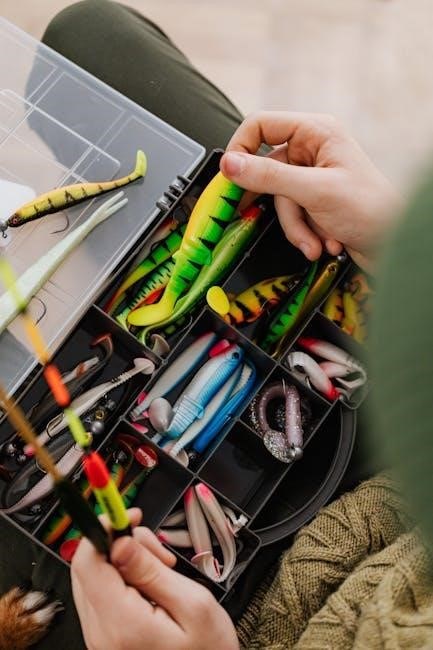A comprehensive guide detailing RV electrical hookup systems‚ including shore power‚ wiring‚ converters‚ and safety protocols. Ideal for DIY installations‚ ensuring safe and efficient connections.
Overview of Electrical Hookups for RVs and Motorhomes
Electrical hookups for RVs and motorhomes are essential for connecting to external power sources‚ enabling the operation of appliances and systems. Shore power‚ typically supplied through a designated inlet‚ provides a reliable energy source. The setup includes wiring‚ circuit breakers‚ and converters to manage power distribution. Proper installation ensures safety and efficiency‚ adhering to electrical codes. Key components like inverters and batteries support off-grid use‚ while grounding and surge protection devices enhance safety. Understanding the system layout and connections is crucial for troubleshooting and maintaining functionality. This overview highlights the fundamental aspects of RV electrical hookups‚ ensuring a secure and efficient power supply for recreational vehicles.

Components of a Hook Up System
A hook up system includes shore power inlets‚ wiring‚ circuit breakers‚ inverters‚ converters‚ and batteries. These components ensure safe and efficient power distribution and management.

Shore Power Inlet: Types and Specifications

The shore power inlet is a critical component of an RV’s electrical system‚ enabling connection to external power sources. Common types include 30A‚ 50A‚ and 240V inlets‚ designed to meet varying power requirements. Typically located on the exterior of the vehicle‚ these inlets are constructed with durable materials to withstand environmental conditions. Proper installation ensures safe and efficient power delivery to the RV’s electrical system. It’s essential to match the inlet type to the RV’s electrical capacity to avoid overloading. Weather-resistant covers and secure locking mechanisms are standard features to protect against misuse. Always consult the RV’s manual for specific inlet specifications and ensure professional installation for safety and compliance with electrical codes.

Wiring Requirements: Materials and Gauges
Proper wiring is essential for safe and efficient electrical connections in RVs. Copper wiring is the standard due to its excellent conductivity and durability. The appropriate wire gauge must be selected based on the current requirements of the system. Common gauges for RV wiring include 10 AWG and 12 AWG‚ with 10 AWG handling higher currents and 12 AWG suitable for lighter applications. Using the correct gauge prevents overheating and ensures reliable power delivery. Always follow industry standards‚ such as those from ASTM or SAE‚ to ensure compliance and safety. Properly sized wiring materials are crucial for maintaining the integrity and efficiency of the electrical system‚ ensuring it operates safely under various conditions.
Circuit Breakers and Electrical Panels
Circuit breakers and electrical panels are crucial components of an RV’s electrical system‚ ensuring safe and reliable power distribution. Circuit breakers act as protective devices‚ interrupting the flow of electricity in case of an overload or short circuit‚ preventing damage or fire hazards. They are typically installed in the main electrical panel‚ which serves as the central hub for power distribution. Panels should be rated for the total electrical load of the RV and include dedicated circuits for high-power appliances like air conditioners or water heaters. Proper installation ensures easy access for maintenance and troubleshooting. Always use circuit breakers with the correct amperage rating for your system‚ and ensure panels are constructed from durable‚ heat-resistant materials to handle continuous operation safely.
Converters and Inverters: Function and Installation
Converters and inverters are essential for managing power in RV electrical systems. Converters transform AC shore power to DC voltage‚ charging batteries and powering DC devices. Inverters‚ conversely‚ convert DC battery power to AC for appliances like TVs or microwaves when shore power is unavailable. Proper installation involves connecting inverters to the battery and ensuring converters are grounded for safety. Both devices should be placed in well-ventilated areas to prevent overheating. Choosing the correct size and type is critical to meet the RV’s power demands. Regular maintenance‚ such as checking connections and cooling systems‚ ensures reliability. These components are vital for seamless power conversion‚ enabling efficient and safe operation of electrical systems in RVs and motorhomes.
Batteries: Selection and Connection
Selecting the right battery for your RV is crucial for reliable power supply. Deep-cycle batteries are ideal for RVs‚ as they provide consistent power over extended periods. Consider the ampere-hour (Ah) rating and voltage to match your electrical needs. For larger systems‚ multiple batteries can be connected in parallel or series to increase capacity. Proper connection involves securing cables to terminals and ensuring polarity is correct. Always disconnect the negative terminal first to prevent short circuits. Use heavy-duty cables and ensure connections are tight to minimize resistance. Regularly check electrolyte levels and charge batteries when not in use to prolong lifespan. Correct installation ensures safe and efficient power storage for your RV’s electrical system.
Safety Considerations
Electrical hookups require strict adherence to safety codes to prevent hazards. Proper grounding‚ insulation‚ and surge protection are essential. Regular inspections ensure system integrity and prevent fire risks.
Understanding Electrical Codes and Regulations
Understanding electrical codes and regulations is crucial for safe and compliant hookups. These codes‚ often mandated by local and national authorities‚ provide guidelines for installing‚ maintaining‚ and using electrical systems. They ensure safety by specifying requirements for voltage‚ wire sizing‚ connections‚ and grounding. Key standards include the National Electric Code (NEC) and regulations from the National Fire Protection Association (NFPA). Adhering to these codes helps prevent electrical hazards‚ fires‚ and shocks. Familiarizing yourself with local regulations is essential before starting any hookup project. Non-compliance can lead to legal issues‚ fines‚ or increased insurance risks. Always consult certified professionals if unsure about specific requirements.
Grounding and Bonding: Essential Safety Practices
Grounding and bonding are critical safety practices in electrical hookups to prevent shocks and ensure safe operation. Grounding involves connecting electrical systems to the earth‚ providing a safe path for fault currents. Bonding ensures all metal components are at the same electrical potential‚ eliminating voltage differences that could cause arcing or sparks. Proper grounding and bonding protect people and equipment from electrical hazards. The National Electric Code (NEC) outlines specific requirements for grounding and bonding in RV and motorhome systems. Using high-quality materials‚ like copper wires and connectors‚ ensures reliability. Regular inspections are essential to maintain the integrity of these systems and prevent potential risks. Always follow certified standards to guarantee safety and compliance.
Surge Protection Devices: Installation and Benefits
Surge protection devices are essential for safeguarding RV electrical systems from power surges and voltage spikes‚ which can damage sensitive electronics and appliances. These devices act as a barrier‚ preventing potential damage and ensuring system reliability. Proper installation near the electrical panel or shore power inlet is crucial for effectiveness. Selecting a device with appropriate voltage and current ratings is necessary for reliable operation. Regular maintenance and inspections help maintain their protective capabilities. Investing in high-quality surge protection devices not only prevents costly repairs but also enhances safety and system longevity.
Fire Prevention Measures in Electrical Systems
Fire prevention is critical in RV electrical systems to avoid hazards and ensure safety. Proper installation and maintenance of wiring and components are essential to prevent overheating and short circuits; Secure all connections tightly to minimize the risk of arcing‚ and use materials rated for high temperatures. Install smoke detectors near electrical panels and ensure they are functioning correctly. Regular inspections of wiring‚ circuit breakers‚ and connectors can help identify potential fire hazards early. Keep flammable materials away from electrical components‚ and ensure proper ventilation in the RV to prevent heat buildup. Regular maintenance and adherence to safety standards significantly reduce the risk of electrical fires‚ protecting both the vehicle and its occupants.

Tools and Materials Needed
Essential tools include wire cutters‚ strippers‚ multimeters‚ screwdrivers‚ and crimpers. Materials like marine-grade wire‚ heat shrink tubing‚ connectors‚ and circuit breakers are crucial for safe installations.
Essential Tools for Electrical Installation
Installing an electrical hookup system requires specific tools to ensure safety and efficiency. A multimeter is crucial for testing voltage‚ current‚ and resistance. Wire cutters and strippers are necessary for preparing wires‚ while screwdrivers and pliers help with connections. A crimping tool is essential for securing terminals. Voltage testers and circuit finders aid in identifying live wires. A drill and bits are needed for making holes for wiring. Safety gear like gloves and goggles should always be worn. Having these tools on hand ensures proper installation and minimizes risks.
Recommended Materials for Wiring and Connections
For a reliable electrical hookup system‚ it’s crucial to use high-quality materials. Wires should be heavy-duty‚ with appropriate gauge ratings to handle the power load without overheating. Insulation is vital to prevent electrical shocks and short circuits. Connectors and terminals should be durable‚ preferably marine-grade or heat-shrink‚ to ensure secure and weather-resistant connections. Fuses and circuit breakers must be rated for the system’s maximum current to protect against overloads. Grounding wire is essential for safety‚ ensuring proper electrical flow and shock prevention. Using sealants or adhesives can protect connections from moisture and dust. Always opt for materials that meet electrical codes and standards for RVs.

Step-by-Step Installation Guide
Plan the layout‚ run wires securely‚ connect components methodically‚ test each connection‚ and ensure compliance with safety standards. Always refer to the manual for specific instructions.
Planning the Electrical System Layout
Planning the electrical system layout is crucial for safe and efficient RV or motorhome hookups. Begin by assessing the power requirements of all appliances and devices. Create a detailed diagram showing the location of components like shore power inlet‚ circuit breakers‚ and batteries. Ensure proper wire routing to minimize interference and damage. Plan for adequate circuit protection and consider future upgrades. Verify compatibility of converters and inverters with your system. Identify optimal placement for solar panels if included. Always adhere to electrical codes and safety standards; Consult a professional if unsure. Use this plan to guide installation and ensure reliability. Proper planning prevents electrical hazards and ensures smooth operation.
Running Wiring Through the Vehicle
Running wiring through an RV or motorhome requires careful planning to ensure safety and functionality. Start by mapping the most direct routes for wires‚ avoiding sharp bends or pinch points. Use marine-grade or RV-specific wiring‚ as it is designed to withstand vibrations and temperature changes. Secure wires with cable ties or conduit to prevent damage. Avoid routing wires near heat sources‚ fuel lines‚ or moving parts. Use grommets when passing wires through walls or floors to protect insulation. Properly label wires for future reference. Test all connections before finalizing the installation. Ensure all wiring meets electrical codes and regulations. This step is critical for avoiding electrical hazards and ensuring reliable power distribution.
Connecting the Shore Power Inlet
Connecting the shore power inlet is a critical step in setting up your RV’s electrical system. Locate the inlet on the exterior of the vehicle and ensure it is securely mounted. Use a marine-grade or RV-specific power cord to connect the inlet to a campground electrical pedestal or a home outlet. Verify the amp rating matches your system (e.g.‚ 30-amp or 50-amp). Tighten all connections firmly and use a weather-tight seal to prevent water intrusion; Connect the inlet to the electrical panel inside the vehicle‚ following the manufacturer’s wiring diagram. Test the connection with a surge protector to ensure proper power flow. Always turn off the main breaker before connecting or disconnecting shore power to avoid electrical shocks.
Installing Circuit Breakers and Panels
Installing circuit breakers and panels requires careful planning to ensure safe and efficient power distribution. Start by selecting a circuit breaker panel rated for your RV’s electrical needs‚ typically 30-amp or 50-amp; Mount the panel in an accessible location‚ such as near the shore power inlet or battery compartment. Connect the shore power inlet to the panel‚ ensuring proper wire gauges are used. Install individual circuit breakers for major appliances like the HVAC‚ water heater‚ and refrigerator. Secure all connections with tightened screws and label each breaker for clarity. Test the system by turning on one circuit at a time to verify proper function. Always refer to the manufacturer’s wiring diagram and safety guidelines to avoid overloading circuits.
Setting Up Converters and Inverters
Setting up converters and inverters is crucial for managing power in your RV. Converters transform AC shore power to DC for charging batteries and powering DC appliances. Inverters convert DC battery power to AC for appliances when shore power is unavailable. Begin by selecting a converter/inverter combo or separate units that match your RV’s power needs. Mount the converter near the battery to minimize voltage drop and ensure efficient charging. Install the inverter in a well-ventilated area to prevent overheating. Connect the inverter directly to the battery using heavy-duty cables. Ensure proper grounding and secure all connections firmly. Finally‚ test the system by running a load test to verify seamless power conversion.

Always follow the manufacturer’s instructions for specific wiring and settings to avoid damage or electrical issues.
Connecting Batteries and Solar Panels
Connecting batteries and solar panels is essential for off-grid power generation; Start by selecting deep-cycle batteries suitable for your RV’s energy needs. Mount them securely in a vented compartment to prevent gas buildup. Install the solar panel on the roof or a tilting mount for optimal sunlight exposure. Connect the solar panel to a charge controller‚ which regulates power flow to the batteries. Use heavy-duty cables to link the batteries in series or parallel‚ depending on voltage and capacity requirements. Ensure all connections are tight and protected from corrosion. Finally‚ integrate the system with your electrical panel to distribute stored energy efficiently. Always follow safety guidelines to avoid overcharging or electrical hazards.
Regularly monitor the system to ensure proper charging and discharging cycles.

Troubleshooting Common Issues
Identify common electrical issues by checking connections and using diagnostic tools. Address wiring faults‚ power fluctuations‚ and system malfunctions promptly. Always follow safety protocols.
Diagnosing Electrical Faults
Diagnosing electrical faults in an RV or motorhome hookup system requires a systematic approach. Start by identifying symptoms‚ such as flickering lights or tripped breakers. Use a multimeter to check voltage levels and continuity in wiring. Inspect connections for corrosion or damage‚ as these are common causes of electrical issues. Verify that all components‚ including circuit breakers and fuses‚ are functioning properly. Consult the wiring diagram in your hook up format PDF to trace circuits and pinpoint faults. Always turn off power before performing diagnostics to ensure safety. By methodically isolating and testing each component‚ you can identify and resolve electrical faults efficiently.
Fixing Common Wiring Mistakes
Fixing common wiring mistakes in RV electrical systems requires attention to detail and adherence to safety protocols. Loose connections are a frequent issue‚ so ensure all terminals are securely tightened. Incorrect wire gauges can lead to overheating‚ so verify that wires match the specified amperage requirements. Reverse polarity is another common error; use a multimeter to confirm proper polarity. Inspect for damaged or frayed wires and replace them promptly. Consult the wiring diagram in your hook up format PDF to ensure connections align with the system design. Always disconnect power before making repairs to avoid shocks or short circuits. By addressing these issues methodically‚ you can restore reliability to your electrical system and prevent future malfunctions.
Resolving Power Supply Problems
Resolving power supply problems in RV electrical systems often begins with identifying the source of the issue. Check the shore power connection to ensure it is securely plugged in and functioning properly. Verify the circuit breaker or GFCI hasn’t tripped due to an overload. Use a multimeter to test voltage levels at the inlet and outlets to detect any drops or inconsistencies. If the issue persists‚ inspect the wiring for damage or corrosion‚ and ensure all connections are clean and tight. Consult the hook up format PDF for diagrams to trace the power supply route. Additionally‚ consider external factors like campground voltage fluctuations and use surge protectors to mitigate such issues. Addressing these steps systematically can help restore stable power to your RV’s electrical system.

Maintenance and Upkeep
Regular inspection of electrical components ensures safe and efficient operation. Clean connections‚ check for wear‚ and replace damaged parts promptly to prevent system failures and ensure reliability.
Regular Inspection of Electrical Components
Regular inspection of electrical components is vital for ensuring the safety and functionality of your hookup system. Start by examining all connections‚ wires‚ and terminals for signs of wear‚ corrosion‚ or damage. Check circuit breakers to ensure they are functioning correctly and test GFCI outlets to confirm they trip when necessary. Verify that all voltage levels are within safe operating ranges using a multimeter. Clean any dirty or corroded connections to maintain proper conductivity. Inspect the shore power cord for cracks or frays and replace it if damaged. Perform these checks every 3 to 6 months or before extended trips to prevent potential issues. A well-maintained system ensures reliable power delivery and minimizes the risk of electrical hazards.
Cleaning and Replacing Worn-Out Parts
Cleaning and replacing worn-out parts is essential for maintaining the integrity of your electrical hookup system. Start by gently cleaning corrosion or dirt from connectors and terminals using a mild detergent and a soft-bristle brush. For severely corroded parts‚ apply a silicone-based lubricant after cleaning to prevent further damage. Inspect all components‚ such as fuses‚ circuit breakers‚ and wiring‚ for signs of wear. Replace any damaged or frayed wires with high-quality‚ marine-grade replacements to ensure durability. When replacing parts‚ always use components that match the original specifications to maintain system compatibility. Regularly cleaning and replacing worn-out parts helps prevent electrical failures and ensures safe‚ efficient power delivery. Always refer to your system’s manual for specific replacement guidelines.
Properly understanding and implementing electrical hookups ensures safe and efficient power delivery for RVs and motorhomes‚ enhancing overall performance and user satisfaction.
The hook up format PDF provides a comprehensive guide to setting up electrical systems for RVs and motorhomes. It covers essential components like shore power‚ wiring‚ circuit breakers‚ converters‚ inverters‚ and batteries. Safety is emphasized through grounding‚ surge protection‚ and fire prevention. Tools and materials are detailed for proper installation. Step-by-step instructions ensure a well-planned electrical layout‚ while troubleshooting and maintenance tips help sustain system performance. By following these guidelines‚ users can achieve efficient and secure electrical hookups for their vehicles. Always adhere to electrical codes and best practices to ensure reliability and safety in all conditions.
Final Tips for Safe and Efficient Hookups
Always ensure compliance with local electrical codes and regulations when setting up your RV or motorhome hookup. Regularly inspect and test your electrical system to identify potential issues early. Use surge protectors and high-quality connectors to safeguard against power fluctuations. Keep emergency shutdown procedures accessible in case of malfunctions. Store cables and wires neatly to prevent tripping hazards. Consider consulting a professional for complex installations. Remember to turn off power sources before performing any maintenance or repairs. Lastly‚ always monitor your system’s performance and stay informed about updates or recalls on your equipment. Safety and efficiency go hand in hand with proper planning and attention to detail.
